GAME TESTS
When nVidia announced the 900 series it touted it’s performance improvements over the Kepler based 600 series as they are clearly targeting current 600 series owners with Maxwell. So, we thought we’d put their claims to the test and put the 970 up against the GTX 670 and GTX 680, however we decided to make things a little more interesting and overclock both cards first.
For the GTX 670, we’ll be using an EVGA GTX 670 FTW overclocked to 1262MHz on the GPU Boost Clock and 6408MHz on the Memory Clock. The GTX 680 will be a reference ASUS model overclocked to 1208MHz on the GPU Boost Clock and 6200MHz on the Memory Clock.
MIDDLE EARTH: SHADOW OF MORDOR
Monolith’s latest game based in the Lord of the Rings universe has gotten a lot of well deserved attention recently. It’s an open world game that features advanced AI and high-resolution textures. So, it should be a good test for our ASUS Strix GTX 970.
For our tests we’ll be running it at both 1080p and 1440p at the “Ultra” preset.

As you can see at 1080p the 970 Strix plays this game easily at max settings despite its exaggerated 6GB vRAM requirement for the high-resolution textures. It steadily outscores its predecessor the GTX 670 and maintains an average of 77.92 FPS and 85.35 FPS while overclocked.

At 1440p it’s much of the same, averaging nearly double the FPS and providing a very playable 56.43 FPS at stock and an increase just shy of 10% while overclocked.
It’s worth noting that we wanted to include the GTX 680 in this test but were having issues getting it to run the benchmark. It will be included in all the tests hereafter.
TOMB RAIDER (2013)
Crystal Dynamic’s successful 2013 reboot of the Tomb Raider series is easily one of the most beautiful games released that year and it still competes graphically with many games released recently.
We’ll be testing it at both 1080p and 1440p at the “Ultimate” preset with TressFX hair effects on and FXAA anti-aliasing.
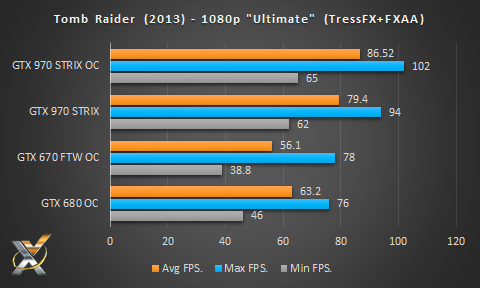
Once again the ASUS Strix GTX 970 manages to maintain an average of over 85 FPS and beats our overclocked GTX 680 by over 35% and manages to beat the overclocked GTX 670 FTW by over 50%.
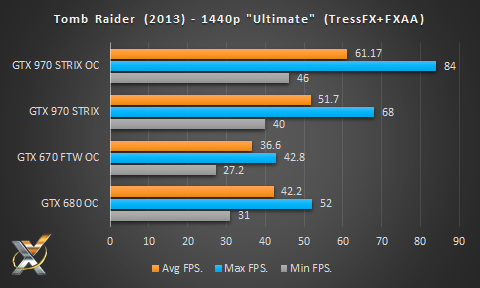
At 1440p the distance between the overclocked Strix 970 and the 670 FTW grows even further at just about 70%, as it delivers a very smooth average of 61.17 FPS. No doubt these results are due widely to the difference in compute power. As the 970 offers a total of 1664 CUDA Cores versus 1536 on the 680 and a mere 1344 on the 670.
CRYSIS 3
the third installment of Crytek’s Crysis is one of the most beautiful and graphically intensive games available. The Crysis series has a long track record of being incredibly demanding which makes them perfect for benchmarking.
We’re testing it at both 1080p and 1440p at “Very High” settings with FXAA anti-aliasing.
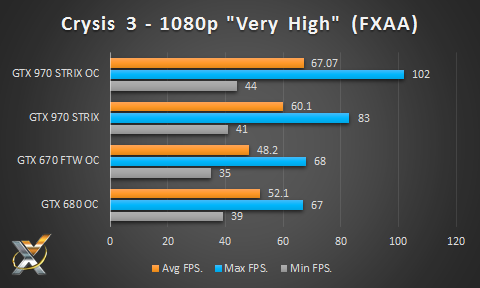
Here we can see a difference of about 40% between the overclocked Strix 970 and the overclocked 670 FTW. What’s more the 970 manages to average frame rates above 60 FPS at both stock and overclocked.
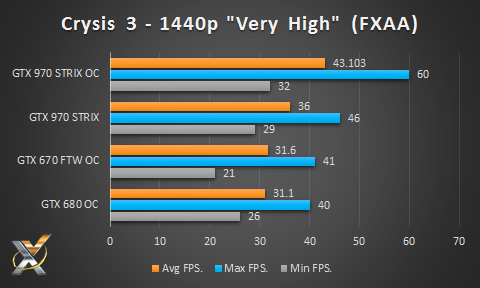
At 1440p the overclocked Strix still provides a playable experience never dropping below 30, although most users would probably want to drop their settings down a bit in order to get a much smoother 60 FPS.
HITMAN: ABSOLUTION
The latest installment of the long-running series by IO Interactive, Hitman: Absolution offers some of the best looking lighting and post-processing effects. It also features small but detailed environments and fairly high-resolution textures.
Like all the other tests, we’ll be running the benchmark at both 1080p and 1440p on the “Ultra” preset with no MSAA anti-aliasing.
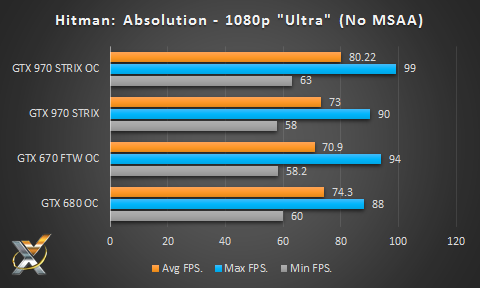
Here we can see that all the cards manage to deliver a very smooth frame-rate, while the overclocked 970 Strix is the only card to deliver an average of 80 FPS, the stock 970 actually loses ever so slightly to the overclocked GTX 680 with lower average and minimum FPS. This is most likely due to the fact that the drivers for the 970 are quite new and probably lack optimizations for many older games and this game is easily the oldest game in our test.
However at 1440p both the stock and overclocked 970 manage to steadily outpace the Kepler GPUs. With the largest performance gap being nearly 45%. It’s also the only card to deliver an average frame-rate of above 60 FPS.
BIOSHOCK INFINITE
The third installment of the Bioshock Franchise brings us to a brightly colored and beautifully stylized world. It isn’t the most graphically intensive game but it sure is purrty.
We’ll be testing it using the built-in benchmarking tool at both 1080p and 1440p with the “Ultra” preset with DDoF (Dynamic Depth of Field) enabled.
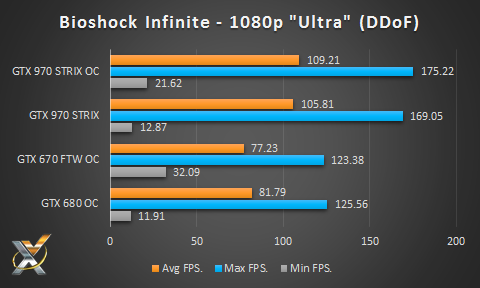
At 1080p the 970 Strix manages to break over 100 FPSon average and beats the 670 by around 42% and the 680 by about 33%.
It’s also worth noting the minimum and maximum FPS are a bit all over the place as is usually the case with this benchmark due to its scene changes, actual gameplay will not likely have such drops with high-end video cards.
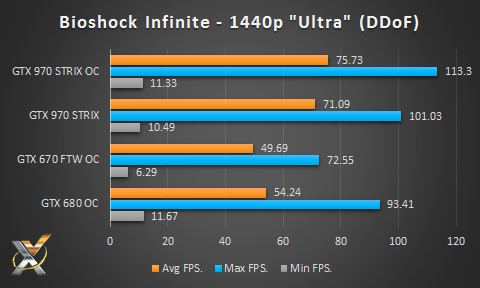
At 1440p the difference is much more drastic, with both Kepler cards being unable to deliver an average of 60 FPS or better where the Maxwell based 970 manages averages above 70 at stock and while overclocked. The 970 proves time and time again that it is the card for 1440p gaming.
Review Overview
Design
Features
Build Quality
Price
Warranty
Maxwell is excellent!
The ASUS Strix GTX 970 OC combines great build quality, fantastic cooling and overclocking with top of the line gaming performance and Maxwell’s impressive efficiency at a very appealing price.
 Technology X Tomorrow's Technology Today!
Technology X Tomorrow's Technology Today!

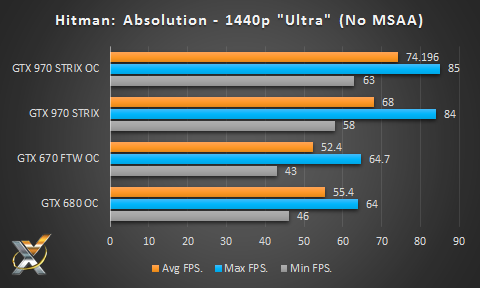
Nice review.
It was kind of scary for me though, we basically have the same rig. ASRock x79 Extreme4, i7 3820 @ 4.4GHz, Corsair TX850v2, GTX 670 FTW (Strix is in the mail), Samsung 840 250gb OS drive…. I thought maybe you were me from the future, writing a review for my past self.
ARE YOU A WIZARD?
Did we just become best friends?
Do you wanna go do karate in the garage?
what are you gonna do with your gtx 670 hehe can i have it.
Sold 1 to my office, the second one is in my HTPC.